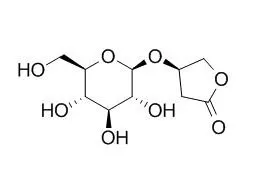| Animal Research: |
| Osteoporos Int. 2013 May;24(5):1663-76. | | Kinsenoside prevents ovariectomy-induced bone loss and suppresses osteoclastogenesis by regulating classical NF-κB pathways.[Pubmed: 23143538 ] | Kinsenoside is able to improve bone turnover rate in ovariectomized (OVX) mice. In vitro analysis shows that Kinsenoside antagonizes osteoclast development and bone resorption.
Kinsenoside, the main active compound of the traditional Taiwanese herb Anoectochilus formosanus, has an antiinflammatory effect. This study investigates whether Kinsenoside inhibits osteoporosis and osteoclastogenesis.
METHODS AND RESULTS:
OVX mice were used to examine the antiosteoporotic activity of Kinsenoside. The trabecular bone microarchitecture was assessed by microcomputed tomography. In vitro experiments were performed to determine the mechanisms of the antiosteoporotic effects of Kinsenoside.
Microcomputed tomography scanning showed that Kinsenoside suppresses bone loss in OVX mice. Kinsenoside decreases plasma CTx concentration. Reverse transcription polymerase chain reaction (RT-PCR) analysis also showed that Kinsenoside reduces the femoral mRNA expression of tartrate-resistant acid phosphatase (TRAP) and matrix metalloproteinase-9 (MMP-9). Kinsenoside inhibits osteoclast formation in bone marrow cells (BMs) and RAW 264.7 cells. Western blot was used to analyze osteoclast-associated signaling pathways in RAW 264.7 cells. Results show that Kinsenoside does not inhibit IKK phosphorylation but suppresses the phosphorylation of IκBα and p65. Kinsenoside significantly inhibits the RANKL induction of IKK activity. Kinsenoside inhibits the RANKL-triggered nuclear translocations of NF-κB and nuclear factor of activated T cells c1 (NFATc1). RT-PCR was used to analyze osteoclast precursor fusion and resorption-associated gene expression in BMs. Kinsenoside inhibits the expression of cathepsin K (CAK), dendritic cell-specific transmembrane protein, MMP-9, and TRAP.
CONCLUSIONS:
Kinsenoside inhibits osteoclastogenesis from macrophages by attenuating RANKL-induced NF-κB and NFATc1 activities, which in turn, prevents bone loss from OVX mice. | | Shock. 2011 Feb;35(2):184-90. | | Kinsenoside isolated from Anoectochilus formosanus suppresses LPS-stimulated inflammatory reactions in macrophages and endotoxin shock in mice.[Pubmed: 20661184 ] | In the present study, we reported that Kinsenoside, a major component of Anoectochilus formosanus, inhibited inflammatory reactions in mouse peritoneal lavage macrophages and protects mice from endotoxin shock.
METHODS AND RESULTS:
In LPS-stimulated mouse peritoneal lavage macrophages, Kinsenoside inhibited the inflammatory mediators, such as nitric oxide, TNF-[alpha], IL-1[beta], monocyte chemoattractant protein 1, and macrophage migration inhibitory factor production. Furthermore, Kinsenoside decreased the formation of a nuclear factor [kappa]B-DNA complex and nuclear p65 and p50 protein levels. Kinsenoside inhibited nuclear factor [kappa]B translocation through both I[kappa]B[alpha]-dependent and -independent pathway. In contrast, it stimulated anti-inflammatory cytokine IL-10 generation and enhanced the mRNA expression of IL-10 and suppressor of cytokine signaling 3 in the same cells induced by LPS. In an animal model, both pretreatment and posttreatment of Kinsenoside increased the survival rate of ICR mice challenged by LPS (80 mg/kg, i.p.). Pretreatment with Kinsenoside decreased serum levels of TNF-[alpha], IL-1[beta], IL-10, monocyte chemoattractant protein 1, and migration inhibitory factor at 1 h after sublethal dose of LPS (40 mg/kg, i.p.) in mice. In contrast, Kinsenoside enhanced serum IL-10 level at 24 h after LPS injection in mice.
CONCLUSIONS:
In conclusion, Kinsenoside inhibited the production of inflammatory mediators and enhanced anti-inflammatory cytokine generation. Therefore, Kinsenoside can alleviate acute inflammatory hazards. |
|






 Cell. 2018 Jan 11;172(1-2):249-261.e12. doi: 10.1016/j.cell.2017.12.019.IF=36.216(2019)
Cell. 2018 Jan 11;172(1-2):249-261.e12. doi: 10.1016/j.cell.2017.12.019.IF=36.216(2019) Cell Metab. 2020 Mar 3;31(3):534-548.e5. doi: 10.1016/j.cmet.2020.01.002.IF=22.415(2019)
Cell Metab. 2020 Mar 3;31(3):534-548.e5. doi: 10.1016/j.cmet.2020.01.002.IF=22.415(2019) Mol Cell. 2017 Nov 16;68(4):673-685.e6. doi: 10.1016/j.molcel.2017.10.022.IF=14.548(2019)
Mol Cell. 2017 Nov 16;68(4):673-685.e6. doi: 10.1016/j.molcel.2017.10.022.IF=14.548(2019)